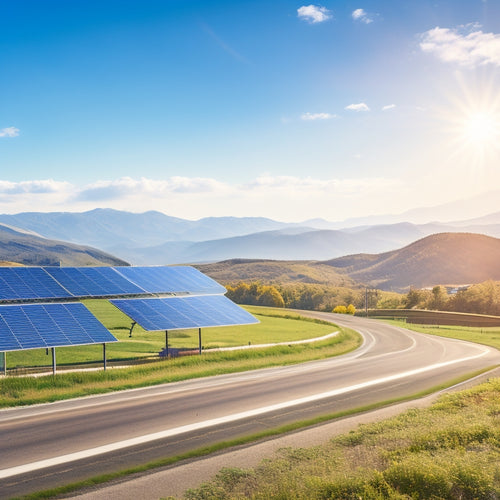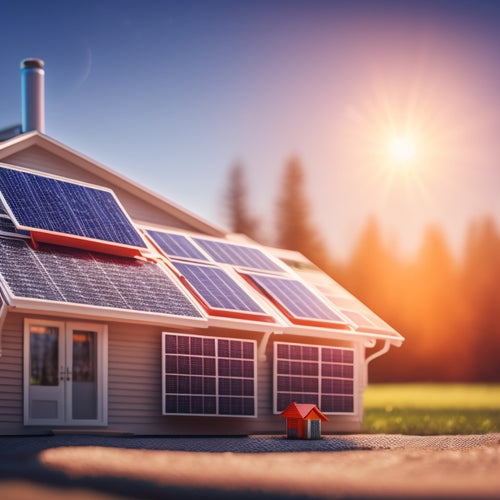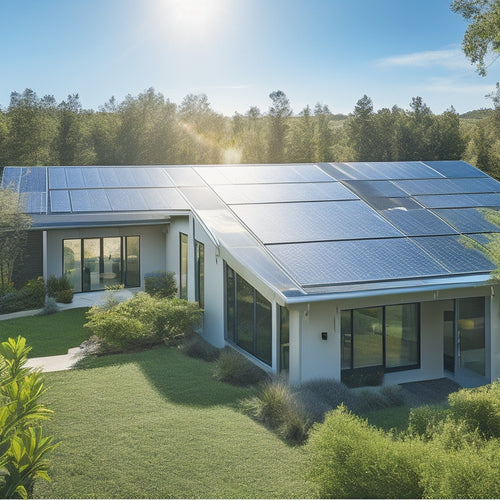
3 Best Battery Packs for Off-Grid Camping
Share
When venturing off-grid, you need a reliable battery pack to power your essential devices at night. Look for high-capacity packs with built-in battery management systems and a high depth of discharge (above 80%) for peak usage. Multiple USB ports, DC, and AC outlets guarantee all your devices stay powered. Consider lightweight options with high energy efficiency and fast-charging capabilities. To narrow down your options, calculate your daily power needs by tallying the watt-hour requirements of your must-have devices. By prioritizing the right features, you'll find a battery pack that meets your off-grid camping needs, and exploring the best options will reveal even more key considerations to enhance your outdoor excursions.
At a Glance
- Identify essential devices and their watt-hour requirements to determine the required battery pack capacity for off-grid camping.
- Select battery packs with high-capacity, efficient energy storage, and built-in battery management systems (BMS) for optimal performance.
- Look for battery packs with multiple charging options (USB, DC, and AC outlets) and solar charge controllers for versatility.
- Prioritize battery packs with high depth of discharge (DOD) above 80% for efficient usage and longer lifespan.
- Consider lightweight and multi-purpose battery packs with fast-charging capabilities for enhanced off-grid camping experiences.
Reliable Power in Darkness
When you're camping off-grid, you need power that doesn't falter when the sun goes down.
You require a reliable source of energy to keep your essential devices running through the night, ensuring your safety and comfort.
With 75% of campers prioritizing portable power for off-grid excursions off-grid energy independence, a well-designed battery pack can provide the nighttime energy security you need to stay connected and informed in the dark.
Power in the Dark
As you venture deeper into the wilderness, darkness falls, and your reliance on artificial light sources grows. One of the biggest concerns when camping off-grid is maintaining power in the dark. Without dependable power, you're left stumbling around in the dark, trying to find your way back to camp.
To avoid this, it's crucial to have a backup plan. Solar panels are a great way to utilize natural energy during the day, but what about when the sun dips below the horizon? That's where backup generators come in. These quiet, portable powerhouses can provide a steady stream of energy, guaranteeing your lights, phone, and other vital devices stay powered up.
When choosing a backup generator, consider the type and size of your battery pack. You'll want a generator that can efficiently recharge your batteries, even in low-light conditions.
Look for models with built-in inverters and high-capacity batteries to make sure you stay powered up throughout the night. With a reliable backup generator and solar panels, you'll have the freedom to camp wherever you want, without worrying about losing power in the dark.
Nighttime Energy Security
Beyond the reach of city lights, nighttime energy security becomes a top priority. You're relying on your battery pack to power essential devices, from lights to communication equipment. A dead battery in the dark can be a serious safety risk.
To guarantee reliable power, you'll want to prioritize battery maintenance tips, such as monitoring your pack's state of charge and avoiding extreme temperatures.
When the sun goes down, solar charging options are limited. That's why it's vital to have a battery pack that can hold its charge throughout the night.
Look for a pack with a high capacity and efficient energy storage. Consider a pack with a built-in battery management system (BMS) to prevent over-discharge and prolong its lifespan.
Extended Camping Trips Possible
With a reliable battery pack, you can extend your off-grid camping trips without worrying about running out of power. This means you can stay out longer, venture into more remote areas, and enjoy the great outdoors without the constraints of a dwindling battery life.
Long-Term Power Solutions
When venturing into the wilderness for an extended period, you'll need reliable long-term power solutions to keep your devices charged and your campsite comfortable.
For off-grid camping, solar charging is an excellent eco-friendly option, utilizing the sun's energy to recharge your battery pack. Portable generators are another reliable choice, providing a steady supply of power whenever you need it. Look for models with a lightweight design, rugged durability, and budget-friendly prices.
When selecting a battery pack, consider capacity ratings, maintenance tips, and user reviews. Brand comparisons can help you make an informed decision.
Some popular brands offer high-capacity batteries with advanced features like built-in inverters and USB charging ports. Others prioritize compact size and lightweight construction, making them ideal for backpackers.
Be sure to research and compare different options to find the best fit for your off-grid camping needs. By investing in a reliable long-term power solution, you can enjoy extended camping trips without worrying about running out of juice.
Powering Remote Adventures
You've invested in a dependable long-term power solution, and now you're ready to take your off-grid camping excursions to the next level. With a sturdy battery pack, you can journey further into the wilderness, staying powered up for extended periods.
Solar generators and portable chargers are vital camping essentials, allowing you to recharge your batteries on the go. Look for lightweight batteries with high energy efficiency to minimize your carbon footprint.
When choosing a battery pack, consider the charging speed, as it can make a significant difference in your camping experience. A fast-charging battery can quickly top up your power reserves, giving you more time to enjoy the great outdoors.
Proper battery maintenance is also essential to guarantee your power solution remains dependable. Effective power management is key to maximizing your battery's lifespan.
Opt for eco-friendly options that align with your values and minimize waste. By selecting the right battery pack, you'll be free to navigate the wilderness without worrying about running out of power, enjoying the ultimate off-grid camping journey.
USB Ports for Devices
You'll appreciate the convenience of multiple USB ports on your battery pack, allowing you to charge several devices simultaneously.
This feature is especially useful when you need to prioritize power to critical devices, such as your phone or GPS, while still keeping other gadgets like cameras or headlamps charged.
When selecting a battery pack, consider the energy storage needs of your devices and choose a pack with a suitable capacity, such as a Lead-Acid or Lithium-Ion option.
Multiple Charging Options
Your off-grid camping battery pack's multiple charging options guarantee that all your devices stay powered up throughout your escapade.
Having multiple charging options means you're not limited to just one way of keeping your devices powered. With USB ports, DC ports, and even AC outlets, you can charge your devices simultaneously, ensuring you stay connected and entertained during your camping trip.
Considering solar compatibility, look for battery packs with built-in solar charge controllers, allowing you to utilize the sun's energy to recharge your battery. This feature is especially useful for extended camping trips where access to power outlets is limited.
When choosing a battery pack, weight considerations are vital. Opt for a lightweight option that still provides ample power storage, making it easy to transport to your campsite.
A battery pack with multiple charging options provides the flexibility you need to power your devices on the go.
Whether you're camping for a weekend or a week, a reliable battery pack with multiple charging options keeps you connected and powered up, giving you the freedom to enjoy the great outdoors without worrying about running out of juice.
Device Power Priority
Freedom from battery anxiety begins with a battery pack that prioritizes device power. You want to guarantee your devices stay charged without draining the battery pack's energy. A key consideration is the number and type of USB ports, as well as their power output.
| Device | Power Priority |
|---|---|
| Smartphone | High |
| Laptop | High |
| Camera | Medium |
| Headlamp | Low |
| Portable Speaker | Low |
When choosing a battery pack, consider the devices you'll be using and their power requirements. If you need to charge multiple devices simultaneously, look for a pack with multiple USB-A ports, USB-C ports, or a combination of both. Energy efficiency is vital, so opt for a pack with a high capacity and low self-discharge rate. Device compatibility is also important, so verify the pack supports your devices' charging protocols, such as QuickCharge or Power Delivery. By prioritizing device power, you can enjoy your off-grid camping trip without worrying about running out of juice.
Count Your Watt-Hours Needs
You'll need to calculate your daily power needs to guarantee your off-grid camping setup can support your devices.
Start by identifying the essential devices you can't live without, such as lights, laptops, and phones, and then determine how many watt-hours they require per day.
When sizing your battery bank, accurate load forecasting is vital to meet your daily power demands.
By analyzing your energy consumption patterns and implementing energy-efficient appliances, you can minimize your overall power consumption.
Calculate Daily Power Needs
Calculating daily power needs involves tallying up the total watt-hours required to run your off-grid camping setup. You'll need to take into account the devices you'll be using, their power ratings, and how long you'll use them each day.
Start by making a list of your devices, including lights, laptops, and refrigerators. Note their power ratings in watts and how many hours you'll use them daily.
Next, calculate the total watt-hours needed for each device. For example, if you have a 20-watt light that you'll use for 5 hours, you'll need 100 watt-hours (20 watts x 5 hours).
Add up the watt-hours for all your devices to get your total daily power needs. When choosing a battery pack, make sure it can provide at least this amount of power.
To maximize your energy efficiency, consider solar panel integration to recharge your battery pack during the day.
Also, follow energy efficiency tips like using LED lights, turning off devices when not in use, and using power strips to plug in multiple devices and turn them off with one switch.
Prioritize Essential Devices
Having determined your total daily power needs, it's now significant to prioritize the devices that are must-haves for your off-grid camping expedition. You can't power everything, so focus on the essentials. Identify the devices you absolutely need, such as your phone, laptop, and lights.
Consider the watt-hour requirements of each device and allocate your power budget accordingly. Create a device compatibility checklist to guarantee the battery pack you choose can power all your essential devices.
Don't forget to factor in battery maintenance tips, like keeping your batteries away from extreme temperatures and avoiding deep discharging. Remember, a well-maintained battery will last longer and perform better.
Prioritize devices that serve multiple purposes, like a portable power station with built-in lights and USB charging ports. Be realistic about your power needs and prioritize devices that are vital for your safety and comfort.
Higher Depth of Discharge
When you're selecting a battery pack for off-grid camping, you'll want to contemplate one with a higher depth of discharge, which allows you to use more of the battery's capacity without damaging it.
This is especially important if you expect to be camping for extended periods or need to power energy-hungry devices. A battery with a deeper cycle capability can provide more usable power and reduce waste, making your camping trip more efficient and enjoyable.
Deeper Cycle Capability
Your off-grid camping setup relies on a battery pack's ability to store and deliver power efficiently. When it comes to deep cycle batteries, a deeper cycle capability means you can tap into more of the battery's capacity without damaging it. This is essential for off-grid camping, where renewable energy sources like solar or wind power may not always be available.
A higher depth of discharge (DOD) allows you to use more of the battery's stored energy before recharging, reducing the frequency of recharging and making your setup more efficient. Look for battery packs with a high DOD, typically above 80%. This means you can use 80% of the battery's capacity before recharging, leaving 20% as a buffer to prevent damage.
A deeper cycle capability also translates to a longer battery lifespan, as you're not constantly stressing the battery with full discharges. When choosing a battery pack, prioritize those with a high DOD and a sturdy build to guarantee reliable power delivery for your off-grid camping excursions.
Frequently Asked Questions
Can I Charge My Battery Pack With a Solar Panel?
You can charge your battery pack with a solar panel, but consider the panel's efficiency and your battery's capacity to optimize charging time; a 100W panel can take 5-10 hours to fully charge a 500Wh battery, depending on sunlight and panel quality.
How Do I Prevent Battery Packs From Overheating in Hot Weather?
When camping off-grid, you'll want to prioritize battery maintenance to prevent overheating. You're doing the right thing by thinking ahead! Implement cooling techniques like shading your pack, improving airflow, and monitoring temperatures to guarantee your batteries stay healthy and efficient.
Are Battery Packs Compatible With All Types of Camping Gear?
You're probably thinking you'll need a PhD in battery compatibility to guarantee your pack plays nice with all your gear, but fear not! Most battery packs are designed to be versatile, offering a range of power capacity options to seamlessly integrate with your camping gear.
Can I Use Multiple Battery Packs to Increase Overall Power Capacity?
You can definitely connect multiple battery packs to enhance your overall power capacity, but it's essential to evaluate compatible battery pack configurations and advanced power management techniques to guarantee safe and efficient energy distribution.
Do Battery Packs Come With Built-In Inverters for AC Devices?
As you venture into the wilderness, you're wondering if your battery pack has a built-in inverter to power AC devices. Well, some battery pack types, like sine wave and modified sine wave, come with built-in inverters, but be mindful of inverter efficiency to guarantee peak performance.
Explore More
As you journey into the wilderness, a reliable battery pack becomes your lifeline. Imagine the stars twinkling above, your campsite aglow with the soft hum of your devices. With the right battery pack, you can stay connected, steer, and capture memories without worrying about running out of juice. By choosing the perfect pack for your off-grid expedition, you'll gain the freedom to roam, unshackled from the grid, and bask in the serenity of the great outdoors.
Related Posts
-

Is Switching to Green Energy Solutions Easy
Switching to green energy solutions isn't just easy; it's also beneficial. You can greatly cut utility costs and enjo...
-

A Beginner's Guide to Navigating the Solar Investment Tax Credit
You're eligible to claim a significant Solar Investment Tax Credit (ITC) of 30% of total installation costs, but mane...
-

Installing Metal Solar Roofs for Maximum Energy Efficiency
Installing metal solar roofs can drastically enhance your home's energy efficiency and durability. These roofs withst...


